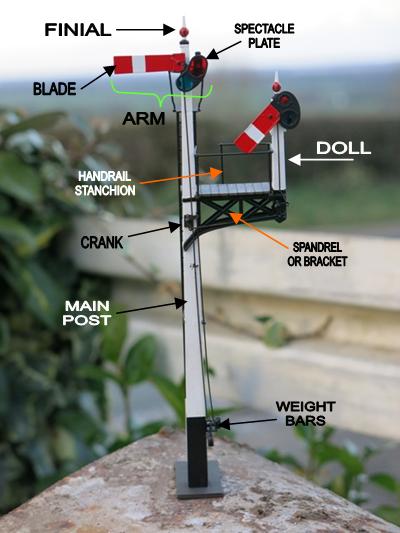The anatomy of a signal. For the purposes of design and ordering, here's just a few details of the various component parts of some signals. This page will be expanded and revised to include various company's designs of signal as and when time permits.
A fairly typical GWR wooden bracket signal...
This would be described as a front view of a "right hand offset" bracket stop signal as the spandrel or bracket hangs off to the right and the arms are stop signal arms. It is "offset" as the structure isn't balanced . The various main parts are labelled.
Main Post; The main support from the ground upwards, this can either extend to the top of the signal or finish where the bracket or spandrels fasten on.
Doll; Any supplementary post on the structure that isn't actually the main post.
Finial; can also be known as the post cap. It's a plain or decorative top applied to posts and dolls to protect them from water ingress at the top.
Spandrel or bracket. Structural support from main post out to the doll(s). These vary immensely depending on the original owning company and age of the signal.
Arm. The signal arm is made up of various components, the main ones being the spectacle plate and the blade. The spectacle plate is weighty casting or pressing that carries the coloured lenses that the lamp shines through. It also has the pivot that the signal rotates on. The blade is the flat plate that extends out from it. It can be wood or pressed steel.
Weightbars. Heavy operating levers, designed to return the signals to danger in the event of the signal wire breaking
Crank. L shaped lever for changing the direction of the operating rods or wires to the signal arms. Other methods to achieve this are chain wheels, rocking arms, horizontal shafts etc.
Handrails and Stanchions. Safety rails and their associated vertical support posts on the lampman's staging area.
